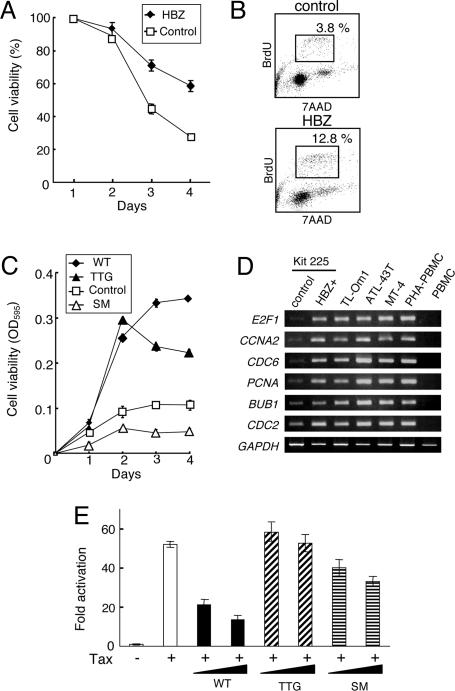Fig. 3.
Functional analyses of the HBZ gene. (A) HBZ gene expression prolongs survival of transfected Kit 225 cells after withdrawal of IL-2. Cell viabilities are measured with 3-(4,5-dimethylthiazol-2-yl)-2,5-diphenyl tetrazolium bromide assay. Values are means ± SD. (B) Cell cycle analyses of HBZ-expressing Kit 225 cells, and Kit 225 cells transfected with a control vector. Cells in S phase were identified by BrdUrd incorporation and staining with 7AAD after withdrawal of IL-2. (C) Effects of wild-type (WT) and mutant forms of HBZ on proliferation of IL-2-stimulated Kit 225 cells. A suboptimal level of IL-2 (2.5 units/ml) was added after removal of IL-2 (48 h), and cell viability was measured by an 3-(4,5-dimethylthiazol-2-yl)-2,5-diphenyl tetrazolium bromide assay. The first ATG of HBZ is mutated to TTG, which blocks synthesis of HBZ protein. All codons in the HBZ gene are replaced with silent mutations (SM). The sequence of SM HBZ has been shown in Fig. 7. (D) Semiquantitative RT-PCR analysis for differentially expressed genes in HBZ-expressing Kit 225 cells compared with control cells. (E) Effects of HBZ and its mutants on Tax-mediated transactivation through the HTLV-I LTR. Lusiferase reporter (WT-Luc) and Tax expressing vector were transfected into Jurkat cells with or without vectors expressing wild-type (WT) or mutated HBZ (TTG or SM) (0.3 or 1 μg). Fold activation were calculated compared with basal luciferase activity of WT-Luc. Results are means ± SD in triplicate.

